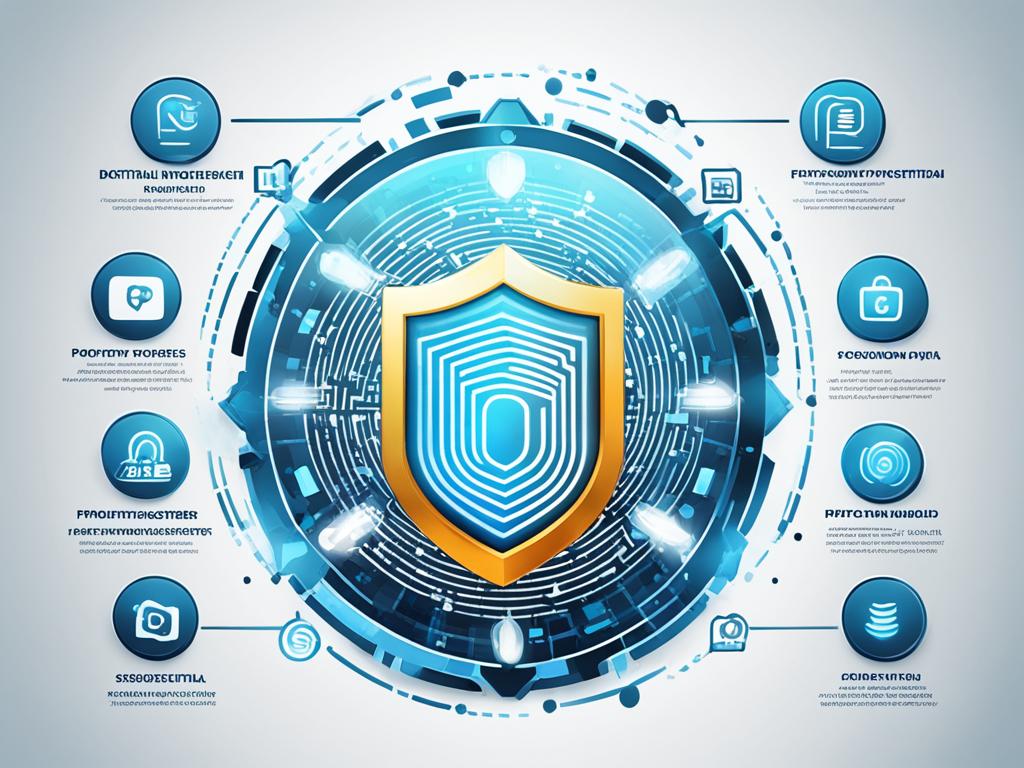In today’s digital landscape, safeguarding intellectual property (IP) has become more critical than ever. The digital age has brought both opportunities and challenges, and businesses must be equipped to protect their valuable assets in this new era. With the rapid advancements in technology and the ease of online sharing, safeguarding ideas, creativity, and inventions has become a crucial task. Protecting intellectual property carries significant importance, as it represents the hard work, talent, and unique ideas of creators and innovators. Failure to protect IP can lead to serious consequences, such as financial losses, reputational damage, and the exploitation of one’s creative work by competitors. Navigating the complexities of intellectual property protection in the digital age requires a comprehensive and proactive approach.
Key Takeaways
- Understand the importance of protecting your intellectual property in the digital age
- Leverage legal mechanisms like patents, trademarks, and copyrights to safeguard your ideas
- Implement robust cybersecurity measures to prevent unauthorized access to your digital assets
- Monitor online platforms and social media for potential infringement of your IP rights
- Consult with intellectual property law experts to develop a comprehensive protection strategy
Understanding Intellectual Property in the Digital Era
In the digital age, intellectual property (IP) has become more complex and multifaceted than ever before. Beyond the traditional physical creations, IP now encompasses a diverse range of intangible assets, including digital content, software, designs, and even business ideas. As we navigate this evolving landscape, it is crucial to understand the various types of intellectual property and the importance of protecting them in the digital landscape.
Types of Intellectual Property
Intellectual property can be categorized into several distinct forms, each with its own legal framework and unique considerations. These include patents, which protect inventions and technological innovations; copyrights, which safeguard creative works such as writings, artworks, and software; trademarks, which protect brand identities and logos; and trade secrets, which cover confidential information and business know-how. Understanding the nuances of these different IP types is essential for developing a comprehensive protection strategy.
Importance of IP Protection in the Digital Landscape
Protecting intellectual property is vital in the digital age, as it enables creators and innovators to reap the rewards of their hard work and creativity. By securing their IP rights, individuals and businesses can prevent unauthorized use, copying, or distribution of their valuable assets, ensuring that they maintain a competitive edge and are appropriately compensated for their efforts. Effective IP protection also fosters continued innovation, as it provides the necessary incentives and safeguards for individuals and organizations to invest in the development of new ideas and technologies.
Challenges of Protecting Digital Assets
The digital landscape presents unique challenges when it comes to IP protection. The ease of unauthorized copying and distribution of digital content, the rise of online piracy, and the increased risk of data breaches and unauthorized access to sensitive information are just a few of the threats that businesses and creators must navigate. Adapting to these challenges requires a comprehensive understanding of the legal frameworks and technological solutions available to safeguard digital IP assets effectively.
Digital IP Management Tools and Strategies
In the digital age, effectively managing and protecting intellectual property (IP) has become a critical priority for businesses of all sizes. Fortunately, we have access to a range of powerful digital IP management tools and strategies that can help us safeguard our valuable digital assets.
Software Solutions for IP Monitoring
Implementing robust software solutions is a crucial step in monitoring and safeguarding our digital IP. These specialized tools allow us to closely track access, usage, and modifications to our digital creations, enabling us to detect and address any unauthorized activities or potential infringements. By proactively monitoring our IP, we can stay one step ahead of potential threats and ensure the integrity of our valuable intellectual property.
Encryption and Digital Rights Management (DRM)
Alongside software-based monitoring, encryption and Digital Rights Management (DRM) systems play a vital role in our digital IP protection strategy. Encryption methods ensure that our sensitive digital data remains confidential and inaccessible to unauthorized users, shielding our trade secrets and other critical information from prying eyes. DRM systems, on the other hand, allow us to control and manage the distribution of our digital content, setting granular access rights and usage limitations to prevent unauthorized access or misuse.
By leveraging these digital IP management tools and strategies, we can effectively safeguard our valuable intellectual property in the ever-evolving digital landscape. From software solutions that provide comprehensive monitoring to encryption and DRM systems that secure and regulate access to our digital assets, these innovative technologies are essential for protecting our ideas and innovations in the digital age.
Enhancing Cybersecurity for IP Protection
As businesses increasingly rely on digital platforms, the threat of cyberattacks and data breaches has grown significantly. These incidents pose a direct risk to intellectual property, and the consequences of IP theft can be severe, including financial losses and reputational damage. Enhancing cybersecurity is a vital aspect of protecting digital IP.
Implementing Robust Security Measures
Implementing robust security measures, such as firewalls, secure passwords, and encryption, is essential to safeguard sensitive information. By fortifying our digital infrastructure, we can create a formidable barrier against unauthorized access and ensure the confidentiality of our valuable intellectual property.
Conducting Regular Vulnerability Assessments
Conducting regular vulnerability assessments to identify and address potential weaknesses in the system is equally important. Regularly evaluating our cybersecurity posture allows us to proactively address vulnerabilities and strengthen our defenses against evolving cyber threats.
Staying Informed on Emerging Cyber Threats
Staying informed about emerging cyber threats and continuously updating security protocols is crucial to proactively protect intellectual property in the digital age. By staying abreast of the latest trends and best practices in cybersecurity, we can anticipate and mitigate potential threats, ensuring the integrity and safety of our digital assets.

Copyright Issues and Content Protection
In the digital age, copyright issues and content protection are central to IP protection. Content creators and rights holders face challenges related to copyright infringement, plagiarism, and content piracy. To protect their digital creations, they must take proactive measures to safeguard their intellectual property and pursue legal remedies when necessary.
Registering Copyrights for Digital Works
One of the essential steps in protecting digital content is registering copyrights for their works. By officially registering their creations, such as websites, articles, images, and software, content creators can establish their ownership and legal rights over the material. This registration process provides them with the necessary documentation to enforce their copyright protection and take action against any unauthorized use or distribution of their digital assets.
Digital Watermarking for Content Traceability
In addition to copyright registration, digital watermarking is a powerful tool for content protection. By embedding invisible or visible markers within digital content, creators can enhance the traceability of their work. This technique allows them to identify the origin of their content and monitor its usage across various online platforms, making it easier to detect and address any copyright violations.
Monitoring Online Platforms for Copyright Violations
Proactive monitoring of online platforms is crucial for content creators and rights holders to identify and address any copyright issues. By continuously scanning the web for unauthorized use of their intellectual property, they can quickly respond to infringements and take the necessary legal actions to protect their content protection. Leveraging automated tools and services can assist in this ongoing copyright monitoring process, ensuring the safeguarding of their digital assets.
Social Media and IP Protection
The digital landscape has revolutionized the way we communicate, share ideas, and promote our brands. However, this newfound connectivity also presents unique challenges when it comes to protecting our intellectual property (IP) rights. As businesses navigate the social media sphere, they must be vigilant in managing their online reputation and safeguarding their valuable assets from potential infringement.
Managing Online Reputation and Brand Damage
In the age of social media, a company’s online reputation can make or break its success. Proactive monitoring of social platforms is essential to quickly identify and address any instances of IP misuse or brand damage. By regularly scanning for unauthorized use of our trademarks, copyrights, or trade secrets, we can swiftly take action to protect our intellectual property and maintain a positive brand image.
Establishing Guidelines for Social Media Use
To mitigate the risks associated with social media, it is crucial to establish clear guidelines and policies for employees and partners regarding the use of these platforms. By outlining the acceptable and unacceptable practices for sharing, posting, and engaging with content, we can help ensure that our intellectual property is not inadvertently or intentionally compromised. These guidelines should encompass best practices for social media usage, content approval processes, and the appropriate steps to report any suspected IP infringement.
Responding Promptly to IP Issues on Social Platforms
When IP issues arise on social media, a swift and effective response is critical. By quickly identifying and addressing instances of copyright infringement, trademark violations, or the unauthorized use of our trade secrets, we can mitigate the damage to our brand and prevent the further spread of infringing content. Leveraging the takedown and reporting mechanisms provided by various social media platforms, as well as engaging with legal counsel when necessary, can help us assert our intellectual property rights and protect our valuable assets in the digital realm.

By proactively managing our social media presence, establishing clear guidelines, and responding promptly to IP issues, we can effectively safeguard our intellectual property and maintain a strong online reputation in the ever-evolving digital landscape.
Protecting Your Ideas Legally
Protecting your intellectual property legally is crucial in the digital age. Registering your intellectual property, such as patents, trademarks, and copyrights, provides legal protection and establishes your ownership. Utilizing the appropriate legal mechanisms can help safeguard your ideas and creations.
Registering Intellectual Property
Registering your intellectual property, including patents, trademarks, and copyrights, is a fundamental step in navigating the complexities of IP protection in the digital landscape. This legal registration process helps establish your ownership and grants you exclusive rights to your innovations, branding, and creative works.
Utilizing Patents, Trademarks, and Copyrights
Patents protect your inventions and novel ideas, ensuring that you reap the benefits of your hard work and innovation. Trademarks safeguard your brand identity, preventing others from using confusingly similar marks. Copyrights shield your original creative works, such as writings, designs, and multimedia, from unauthorized use or reproduction.
Trade Secret Laws and Non-Disclosure Agreements
In addition to formal IP registration, trade secret laws and non-disclosure agreements (NDAs) can be leveraged to protect confidential information and trade secrets. These legal tools prevent unauthorized disclosure or use of your valuable intellectual property by third parties, helping you maintain a competitive edge in the digital age.
Intellectual Property Law and Legal Consultation
In the ever-evolving landscape of intellectual property law, the expertise of IP attorneys is invaluable. These legal professionals possess deep insights into the fundamental principles and nuances of patents, copyrights, trademarks, and trade secrets. They can provide strategic guidance on navigating the complexities of IP law, helping businesses develop comprehensive strategies to protect their valuable intellectual assets. Consulting with IP attorneys is a crucial step in safeguarding intellectual property, as they can offer advice on registration, enforcement, and defense against infringement. Their knowledge and experience are essential in mitigating legal risks, maximizing the value of IP, and ensuring compliance with evolving regulations in the digital age.
“Protecting your intellectual property is not just about safeguarding your ideas – it’s about preserving the foundation of your business’s success and innovation.”
At the core of effective IP protection lies the collaboration with experienced IP attorneys. These legal experts can help you navigate the intricate web of patent law, copyright protection, trademark registration, and trade secret laws. They can also guide you through the process of drafting non-disclosure agreements and licensing agreements, ensuring that your valuable creations and inventions are protected from unauthorized use or exploitation.
By engaging with IP attorneys, you can develop a comprehensive intellectual property strategy that aligns with your business goals and innovation safeguards. Their expertise can help you identify and address potential vulnerabilities, enforce your rights, and leverage your IP for competitive advantage in the digital marketplace.
In an era where digital IP management and cybersecurity are paramount, the guidance of IP lawyers is essential. They can provide invaluable insights on invention disclosure, trade secret protection, and legal consultation to ensure that your most valuable intellectual property rights are protected in the ever-evolving digital landscape.
| Key Benefits of Consulting with IP Attorneys | Potential Risks of Neglecting IP Protection |
|---|---|
|
|
By proactively engaging with IP law experts, businesses can navigate the complexities of the digital age with confidence, ensuring that their most valuable intellectual property is safeguarded and positioned for long-term success.

Building an Effective IP Strategy
Developing an effective intellectual property strategy is crucial for businesses operating in the digital age. This strategy should align with our overall business objectives, ensuring that the protection and management of IP assets support the company’s growth and competitive position.
Aligning IP Strategy with Business Goals
Our intellectual property strategy must be closely aligned with our business goals and priorities. By integrating IP considerations into our broader strategic planning, we can ensure that our valuable assets, such as patents, trademarks, and copyrights, are leveraged to drive innovation, enhance brand recognition, and maintain a competitive edge in the market.
Conducting Regular IP Audits
Conducting regular IP audits is an essential component of our comprehensive IP strategy. These audits allow us to identify and address vulnerabilities in our intellectual property portfolio, as well as explore opportunities to maximize the value of our creative works, inventions, and other intangible assets. By proactively managing our IP, we can stay ahead of the curve and strengthen our position in the digital marketplace.
Leveraging IP for Competitive Advantage
Effectively leveraging our intellectual property can provide us with a significant competitive advantage. From licensing agreements and strategic partnerships to the strategic deployment of patents, trademarks, and copyrights, there are numerous ways we can generate revenue and enhance our market position. By exploring these opportunities and carefully managing our IP, we can transform our creative and innovative efforts into tangible business value.
Innovation Safeguards in the Digital Age
As businesses navigate the digital landscape, safeguarding innovation and intellectual assets has become increasingly crucial. We understand the need to secure confidential information and trade secrets, as well as protect our valuable inventions and intellectual property.
Securing Confidential Information and Trade Secrets
In the digital age, the protection of sensitive data and trade secrets is paramount. We employ robust measures, such as encryption, access controls, and comprehensive employee training, to prevent unauthorized access and misuse of our valuable trade secrets. By implementing these safeguards, we can effectively shield our confidential information from potential exploitation or misappropriation.
Protecting Inventions and Intellectual Assets
Maintaining a competitive edge and incentivizing continued innovation requires the diligent protection of our inventions and intellectual assets. We leverage legal mechanisms, including patents and non-disclosure agreements (NDAs), to safeguard our innovative creations and ideas. These measures ensure that our intellectual property is not exploited or replicated without our permission, allowing us to reap the benefits of our hard work and preserve our position as industry leaders.

Intellectual Property Law and Global Considerations
Protecting intellectual property in the digital age often requires navigating a complex web of international regulations and jurisdictions. As businesses operate in a global marketplace, understanding and complying with various IP laws across different countries is crucial. Strategies for navigating international IP regulations, such as registering trademarks and patents in multiple countries, can help safeguard intellectual property rights.
Navigating International IP Regulations
Businesses must stay abreast of the evolving landscape of intellectual property law on a global scale. This includes familiarizing themselves with the nuances of patent law, copyright protection, trademark registration, and trade secret laws in the countries where they operate. Proactively registering and protecting their intellectual property assets across borders is essential to maintain a competitive edge and prevent unauthorized use or infringement.
Enforcing IP Rights Across Jurisdictions
Enforcing intellectual property rights across different jurisdictions can be a challenging task, often requiring specialized legal consultation and coordination with local authorities. Businesses must be prepared to navigate the complexities of cross-border IP protection and IP enforcement to safeguard their valuable innovations and trade secrets. Leveraging non-disclosure agreements and other legal mechanisms can help strengthen their position when operating in the global digital landscape.
Licensing Agreements and IP Monetization
Intellectual property can be a valuable asset not only for protection but also for monetization. By exploring licensing opportunities and negotiating favorable licensing terms, we can enable businesses to generate revenue and maximize the value of their IP. Granting limited rights to use our intellectual property, such as patents, trademarks, or copyrights, to third parties can create new income streams and leverage our IP for competitive advantage.
Exploring Licensing Opportunities
Licensing our intellectual property can open up a world of opportunities. We can grant others the right to use our patents, trademarks, or copyrights in exchange for royalties or other compensation. This allows us to monetize our creations while maintaining control over their use and ensuring they are not exploited without our permission.
Negotiating Favorable Licensing Terms
However, navigating the complexities of licensing agreements requires careful consideration and legal expertise. We must ensure that the terms of the agreement preserve our IP rights and establish mutually beneficial arrangements. This may involve negotiating licensing fees, usage restrictions, revenue sharing, and other provisions that protect our interests while also incentivizing the licensee to use our intellectual property effectively.

Conclusion
In conclusion, safeguarding intellectual property in the digital age requires a comprehensive and proactive approach. By understanding the types of intellectual property, the importance of IP protection, and the unique challenges posed by the digital landscape, businesses can navigate this complex terrain effectively. Leveraging digital IP management tools, enhancing cybersecurity, addressing copyright and content protection issues, and managing online reputation are all essential components of an effective IP protection strategy.
Engaging with intellectual property law experts and building a robust IP strategy aligned with business goals can further strengthen a company’s ability to protect its most valuable assets. As the digital age continues to evolve, proactively protecting intellectual property will remain a critical imperative for businesses seeking to thrive and maintain a competitive edge in the ever-changing digital marketplace.
By embracing a multifaceted approach to IP protection, organizations can ensure that their innovative ideas, creative works, and proprietary information remain secure and serve as the foundation for their continued success in the digital era.
FAQ
What are the key types of intellectual property?
Why is protecting intellectual property critical in the digital era?
How can digital IP management tools help safeguard intellectual property?
What are the key cybersecurity measures to protect intellectual property?
How can creators protect their digital content from copyright infringement?
How can businesses address intellectual property issues on social media?
What legal mechanisms are available to protect intellectual property?
How can consulting with intellectual property attorneys benefit businesses?
What are the key elements of an effective intellectual property strategy?
How can businesses safeguard innovation and intellectual assets in the digital age?
What are the global considerations in protecting intellectual property?
How can businesses monetize their intellectual property?
Source Links
- https://www.linkedin.com/pulse/navigating-intellectual-property-law-u4wne
- https://www.linkedin.com/pulse/how-safeguard-your-intellectual-property-digital-era-devin-miller-o1gdc
- https://ipworkslaw.com/protecting-intellectual-property-in-the-digital-age/

